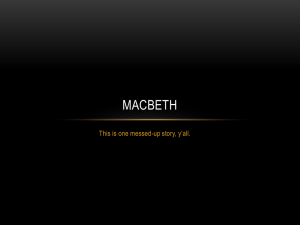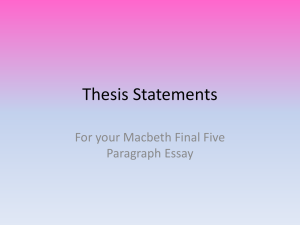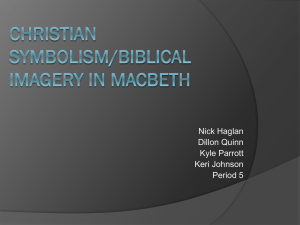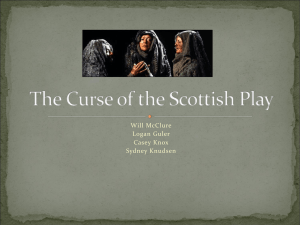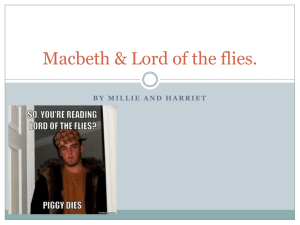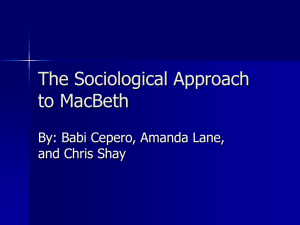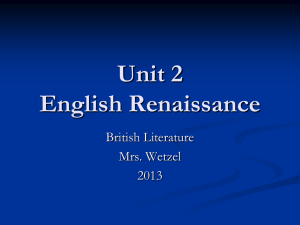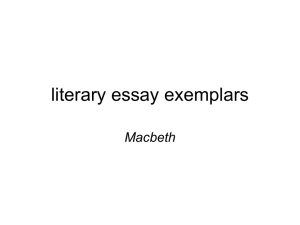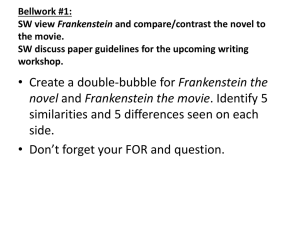CM-3-Bellwork - Dearborn High School
advertisement
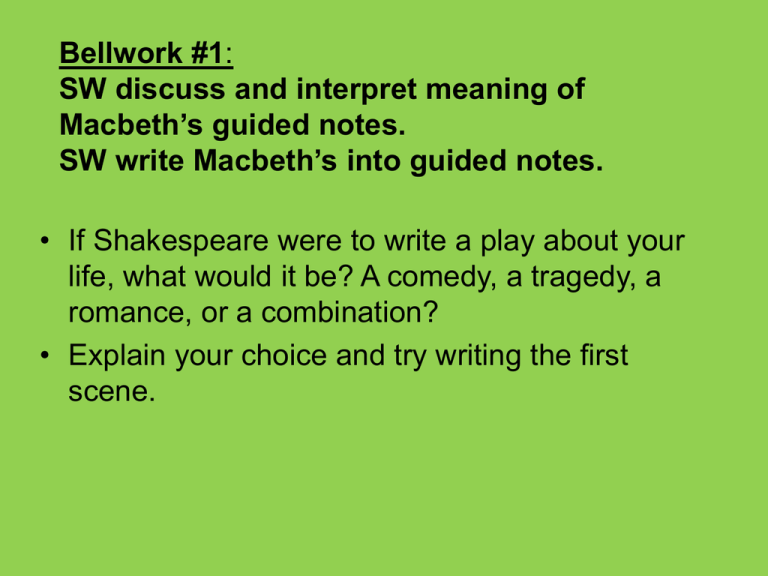
Bellwork #1: SW discuss and interpret meaning of Macbeth’s guided notes. SW write Macbeth’s into guided notes. • If Shakespeare were to write a play about your life, what would it be? A comedy, a tragedy, a romance, or a combination? • Explain your choice and try writing the first scene. Bellwork #2: SW interpret meaning behind academic vocabulary used within Macbeth. SW present and discuss the meaning of the vocabulary with other groups. SW actively read, listen, and discuss Act 1, scene 1. • Create a tree map: • Title it: Literary Terms • Divide it into 3 categories: Tragedies, Tragic Flaws, and Foils. • Think back on past plays, stories, and poems that you have read this year or in previous years and come up with 5 different examples in each category. Bellwork #3: SW actively read, discuss, and interpret Act 1, scene 2 and 3. SW create a 3 column journal entry and T2T, summarize, and look for literary elements. • Analyze and interpret the meaning of the following Shakespearean quote: “Come what come may, time and the hour runs through the roughest day” (Macbeth 1.3). Bellwork #4: SW analyze and interpret the meaning of the AoW. SW write a SOAPSTone in response to the article. • Analyze and interpret the following Shakespearean quote: “There’s daggers in men’s smiles” (Macbeth 2.3). Bellwork #5: SW analyze and interpret Act 1, scene 4-6 while reading, listening, and discussing Act 1. SW create a 3 column journal while T2T, summarizing, and looking for literacy elements within the scenes. • Analyze and interpret the following Shakespearean quote: “Look like the innocent flower, but be the serpent under’t” (Macbeth 1.5). Bellwork #6: SW critically read, interpret, and discuss Act 2, scene 1 & 2. SW write three column notes on these sections. • Answer true or false to the following statements: 1. Shakespeare is the author of Macbeth. 2. All of Shakespeare’s tragedies have a double climax, which is called the Catastrophe. 3.Macbeth was the King of England. 4.“Fair is foul, and foul is fair” is a famous quote from Macbeth. Bellwork #7: SW critically read, interpret, and discuss Act 2, scene 3 & 4. SW write a Flow map based upon Act 2 to recount the events that happened and answer questions based upon it. • What is a Porter? • What is his purpose in the play? • Why does Shakespeare do this? Bellwork #8: SW demonstrate their knowledge on a quiz based upon Act 1 & 2. SW critically read, interpret, and discuss Act 3, scene 1 & 2. • In Act II of Macbeth, why does Macduff believe Donalbain and Malcolm killed King Duncan? Bellwork #9: SW critically read, interpret, and discuss Act 3, scene 3-6. SW write three column notes based upon these sections. • Describe how roles have reversed with Macbeth and Lady Macbeth. How have both of them changed. For the better or worse? Bellwork #10: SW critically read and analyze an AoW and apply a 4 square to it by close and critically analysis. Write 4 square set up for your Bellwork. Take out a lined piece of paper and fold it hamburger style. Label it: First side: What does it say? How does it say it? Second side: What does it mean? So..What does it mean to me? Bellwork #11: SW demonstrate their understanding of Act 3 of Macbeth by taking a quiz on this act. SW critically read, analyze, and interpret Act 4, scene 1. • In Act 3, Macbeth says, “…blood will have blood.” What does he mean? • When talking to Lady Macbeth, he says: “We are yet young in deed.” What does he mean? Bellwork #12: SW Critically read, interpret and discuss Act 4, scene 2 & 3. • List the 3 apparitions shown to Macbeth by the witches. • Explain what each apparition means. Bellwork #13: SW critically read, interpret, and discuss Act 5, scene 2-8. • What does it mean to be not “woman born”? • Who do you suspect this man will be? Bellwork #14: SW apply concepts learned from Macbeth the play to the modern version of the play. SW discuss the stipulations and focus of the formal paper, due January 7th. • Create a Double-Bubble map showing the similarities and differences seem from the play to the modern day version of the movie. Bellwork #15: SW apply concepts learned from Macbeth the play to the modern version of the play. • The idea of “hand-washing” has appeared in Act II Scene II, when Lady Macbeth tells Macbeth to wash his hands after he killed King Duncan. • Lady Macbeth also “washes her hands” in Act V. • What is the deeper meaning of “hand-washing”? Bellwork #16: SW apply concepts learned from Macbeth the play to the film of the play. SW discuss the final project and develop groups to begin working on their project. • Which character in the play has made the biggest transformation in your opinion from good to bad or vise versa. Bellwork #17: SW apply concepts learned from Macbeth to the film version of the play. SW work on their group project and discuss the scene they want to reenact. • Which scene is the most dramatic, in your opinion? What type of props would you create with it? How would you make it interesting without verbalizing it? Explain. Bellwork #18: SW apply concepts learned from Macbeth to the film version of the play. SW work on their group project and discuss the scene they want to reenact. • Create bubble maps based on the following characters: -Macbeth – Banquo – Macduff – L. Macbeth Bellwork #19: SW critique other group presentations/interpretations of scenes in class. SW demonstrate their interpretation of a scene in Macbeth with their group. Critique the presentations you see with a tree map for each group listing their strengths and weaknesses (3 of each). Bellwork #20: SW demonstrate their interpretation of a scene in Macbeth with their group. SW begin reviewing for their final exam. 1. Why was Polynieces, Antigone’s brother, forbidden from being buried? 2. Who is known as the “father of drama”? 3. What was King Creon’s tragic flaw? Bellwork #21: SW demonstrate their interpretation of a scene in Macbeth with their group. SW begin reviewing for their final exam. 1. How many years did Grendel terrorize Hrothgar’s men? 2. In The Canterbury Tales Prologue, during which month does pilgrimage take place? 3. How does the Pardoner make his living? Bellwork #22: SW begin reviewing for their final exam. 1. How many husbands did the Wife of Bath have? 2. In “The Wife of Bath’s Tale”, what did the Knight do that caused him to be punished by the king and queen? 3. In “The Wife of Bath’s Tale”, what does the Knight need to find out in order to save his life?
